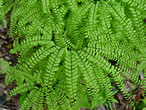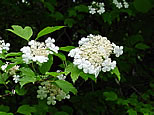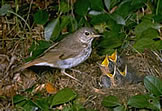
Nature Journal
| |
|
| Saturday, June 21, 2003 | |
| When
I was out walking yesterday, a startled wild
turkey flew up from a spot not more than 4 feet from me. Startled
me, too! At first I thought it was a ruffed grouse, but soon realized that it was a turkey. While making alarm calls, it half-ran and half-flew to a more protected place. I took a quick peek for chicks or eggs. Seeing nothing and not wanting to disturb the hen further, I walked on. Then I heard the hen behind me and turned to see it fly by as though it were trying to distract me. It continued to make alarm calls until I was out of the area. |
|
| Thursday, June 19, 2003 | |
 I've
been noticing the many varieties of ferns that are found in my local
area. The maidenhair fern is one of my favorites. I've
been noticing the many varieties of ferns that are found in my local
area. The maidenhair fern is one of my favorites.This fern grows in rich soil. It can be recognized by its dark stems and the |
|
|
are arranged. |
|
| Tuesday, June 17, 2003 | |
| Have
been seeing very little of the whitetail deer
lately. I did see one of the does a couple of days ago. I noticed
that she had completed her molt and was sporting her reddish summer
coat. I suspect that the doe(s) in my immediate area have either had their fawns or will be giving birth soon. Does become more secretive both before and after the birthing time. |
|
| Sunday, June 15, 2003 | |
 The
Highbush Cranberry (Viburnum trilobum) has been blooming for
a few days now. The large, showy blossoms along the rim of each cluster
distinguish this shrub from the Maple-leaved Viburnum. The
Highbush Cranberry (Viburnum trilobum) has been blooming for
a few days now. The large, showy blossoms along the rim of each cluster
distinguish this shrub from the Maple-leaved Viburnum.Other wildflowers that are blooming |
|
Hawkweed, Blue-eyed Grass, Red Clover, Common Speedwell, Oxeye Daisy, Common Cinquefoil, and Red Raspberry. |
|
| Friday, June 13, 2003 | |
|
The
phoebe has become much more vocal
lately. I've read that this tends to happen when they start their
second brood and the male becomes more territorial in response to
that. |
|
| Wednesday, June 11, 2003 | |
 The
warblers have quieted down a little,
but I heard the hermit thrush singing
in the deep woods today. And saw an indigo
bunting in a more open area. The
warblers have quieted down a little,
but I heard the hermit thrush singing
in the deep woods today. And saw an indigo
bunting in a more open area.Last year, there was a phoebe that |
|
branch on a tree near the house. I noticed today that it has returned to its familiar perch. I think I'm correct in assuming that this is the same phoebe that I saw last year. |
|
| Monday, June 9, 2003 | |
| The
Eastern Tent Caterpillars
began leaving their tent-like webs about 10 days ago and are now roaming
far and wide. Some people confuse this caterpillar with the Gypsy Moth Caterpillar. The Gypsy Moth Caterpillar is usually seen about a month later than the Eastern Tent Caterpillar. The latter has a white stripe down its back while the former does not. |
|
| Top of page |
|
|
| Birds | Butterflies | Mammals |
| Garden Shop |
New England:
Connecticut, Maine, Massachusetts, New Hampshire, Rhode Island, Vermont